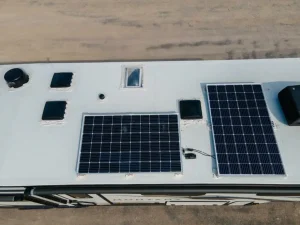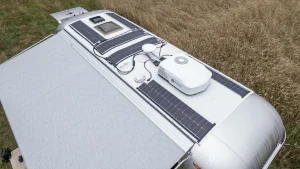When outages rise, bills climb, and roofs aren’t “textbook,” it’s natural to search What Size Solar panels to run a House and feel buried in specs. This guide cuts through the noise with plain-English fundamentals—power vs energy, and Peak Sun Hours (PSH)—plus a quick sizing formula and cheat table so you can work backward from your utility bill to system kW, panel count, and roof area, then choose between grid-tie bill savings or critical-loads backup (and when a battery makes sense).
From there, we bridge theory to reality: shade, low load capacity, and curved surfaces. You’ll see how Sungold’s lightweight, anti-shade approach turns “difficult roofs” into productive arrays, when to mix 400 W glass with 200 W lightweight modules, and how to preserve yield with module-level design. Grab the Rooftop PV Calculator and the EPC/installer handoff checklist at the end to turn these steps into a buildable, quiet, and scalable home solar plan.
Can I really size my system in 3 seconds?
Yes—use “simultaneous running load × 1.5” (to cover motor/ compressor inrush). List the appliances you need to keep on during an outage, sum their rated watts, then multiply by 1.5. That gives a recommended continuous inverter/generator size. For battery energy, estimate total running watts × hours you want to ride through.
| Household scenario | Simultaneous running load* | Recommended generator size | Notes |
|---|---|---|---|
| 1–2 people, gas water/cooking | 2.5 kW | 3–4 kW | Fridge + router + lights + laptop |
| 3–4 people, occasional AC | 4.5 kW | 5–6 kW | 1.5-ton split AC peak ≈ 3.2 kW |
| 4–5 people, 5-ton central AC | 8–10 kW | 10–12 kW | Needs 240 V output and more battery |
| Large home/ BnB with pool pump & dryer | 15 kW | 15–20 kW | Dual-unit parallel cuts single-point risk |
*“Simultaneous running load” = sum of the devices you’ll run at the same time; × 1.5 covers start surges. Not sure? Grab the Rooftop PV Calculator at the end—drop in your bill kWh and it auto-returns kW, panel count, and roof area.
Do I really need to understand power, energy, and sun hours first?
Power (W/kW) decides whether it can run a load; energy (Wh/kWh) decides how long it runs. Peak Sun Hours (PSH) decides how much PV you need to refill the battery and offset your bill.
PSH is your daily full-sun equivalent and depends on city, roof orientation, shading, and season: Guangzhou ≈ 4.2 h, Beijing ≈ 4.8 h, Kunming ≈ 5.5 h (illustrative). An 8 kW array in a higher-PSH city yields more annual kWh. Also don’t confuse instantaneous power with stored energy: a 3 kW inverter isn’t a 3 kWh battery. To ride 10 hours at ~3 kW, you need ≈ 30 kWh of storage—or a PV-by-day + battery-by-night strategy.
Should I go “grid-tie to cut bills” or “critical-loads backup”?
It depends on your goal:
Grid-tie to lower bills (offset): You can skip batteries. A home using ~30 kWh/day often installs 5–8 kW PV and hits > 90% annual offset with decent orientation.
Backup/off-grid continuity: Move must-run circuits (fridge, lights, internet, gas-furnace blower, some AC) into a critical-loads panel, then add 5–10 kWh batteries and a hybrid/ESS inverter for millisecond-class transfer and daytime solar charging.
One-night example (8 h):
| Critical load | Rated power | 8-hour energy |
|---|---|---|
| Inverter fridge | 400 W | 3.2 kWh |
| 1.5-ton inverter AC | 1,200 W | 9.6 kWh |
| Lights + router + laptop | 200 W | 1.6 kWh |
| Gas-furnace blower | 200 W | 1.6 kWh |
| Total | 2 kW | 16.0 kWh |
→ Choose a 3 kW inverter + ≥ 20 kWh battery to run ~24 h straight; add ~6 kW PV and sunny-day runtime is effectively “self-refilling.”
What if my roof has shade, low load capacity, or curved surfaces?
Sungold fixes “can’t install” roofs with lightweight, anti-shade, custom-fit modules so marginal sites become viable.
| Roof challenge | Sungold approach | Outcome |
|---|---|---|
| Steel sheet roof ≤ 5 kg/m² load | PA621 lightweight flexible (~2.2 kg/m²) | Avoid heavy structural reinforcement and extra penetrations; cut leak risk & cost |
| South face shaded by chimney/ parapet | Cell-level bypass + microinverters/optimizers | Shade isolates only the bad zone; the rest of the module keeps producing—far better than classic strings |
| Skylights/ light curvature | PA219 bendable with adhesive install | Fewer penetrations, lower wind noise/ uplift, more edge/ corner utilization |
| Small triangles/ odd scraps | Custom 200 W small formats | Turn “wasted” roof patches into real kW to lift site capacity |
Which gear fits each scenario best without overkill?
Think in blocks: inverter + battery + PV. Jackery covers inverter + battery; Sungold covers the roof-side PV.
Jackery snapshot (key specs for quick picks)
| Model | Battery energy | Continuous power | 240 V | 1.5-ton AC* | Gas-furnace blower* | Transfer Switch |
|---|---|---|---|---|---|---|
| 2000 Plus (4 kWh) | 4 kWh | 3 kW | × | ≈ 2.8 h | ≈ 17 h | optional |
| 2000 Plus (6 kWh) | 6 kWh | 3 kW | × | ≈ 4.2 h | ≈ 25 h | optional |
| 3000 Pro | 3 kWh | 3 kW | × | ≈ 2.1 h | ≈ 12 h | optional |
| 5000 Plus | 5–60 kWh scalable | 7.2 kW | √ | ≈ 12 h (10 kWh est.) | ≈ 71 h | standard/ optional |
*Runtime estimates assume typical loads; conditions and efficiency vary. Keep 15–20% safety margin.
Sungold: Use SGM 400 W rigid solar panels on standard roofs; choose PA621/PA219 lightweight flexible (with cell-level anti-shade) for low-load, curved, or partially shaded areas. Mix-and-match to maximize area and recover capacity.
What Size Solar Panels to Run a House—FAQs you’ll actually use
Q1: I already have 9 kW grid-tied PV—does it work in a blackout?
Grid-tie arrays shut down for line safety. nights draw from storage—power when the sun shines.
Q2: Do AC and gas furnaces really eat that much power?
A 1.5-ton inverter split often averages ~1.2 kW; gas-furnace blowers 200–600 W. With 10 kWh battery, expect ~8 h AC runtime, and a furnace alone can run through the night. PV by day stretches runtime further.
Q3: Can I start small and expand later?
Yes. 2000 Plus stacks to 4–24 kWh; 5000 Plus scales 5–60 kWh. Buy the inverter + base battery now and add packs as needs grow.
Q4: Are lightweight flexible panels less durable/ efficient?
PA621/PA219 use ETFE + fluoropolymer dual-weather layers; UV aging 3,000 h with < 5% drop (lab reference). Cell-level bypass reduces hotspots. Typical power warranty is ~15 years. On complex roofs, better shade resilience + coverage can beat glass-only layouts on delivered kWh per square meter.
Q5: Grid-tie vs backup—do I need a battery?
To cut bills, not necessarily. For outage/ off-grid operation, yes—pair batteries with a hybrid/ESS inverter. Many homes choose grid-tie + modest backup: 5–8 kW PV for savings, 5–10 kWh battery to ride through events.
How do I get the Rooftop PV Calculator and use it to decide?
Easy:
Download the Excel (comes with sample data and editable parameters)
Enter your last 12 months of kWh and pick your city’s PSH (reference list included)
One-click outputs:
Recommended system kW
400 W rigid panel count
200 W lightweight panel count
Estimated roof area and offset %
Jackery backup combos (3/6/12 kW) with continuous runtime
Download link: [Rooftop PV Calculator | Excel] (add a button/QR on your site).
Want it precise? Send roof photos/ sketch + your monthly bill—we’ll return a shade analysis and stringing concept so you and your installer can align quickly.
Bottom line—why is this combo the most realistic path?
Real roofs aren’t perfect. Parapets, chimneys, signs, gutters, curves—and structural limits—are normal. Sungold lightweight + anti-shade turns “can’t install/ won’t perform” into capacity recovered; Jackery keeps critical loads alive with scalable storage. First drive offset, then nail backup. The result is powerful, quiet, and cost-steady—both on ordinary days and in extreme weather.







